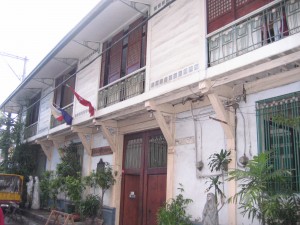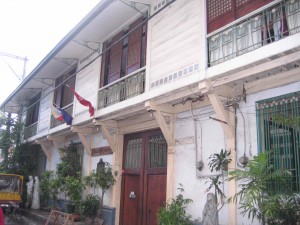By JON LINDLEY C. AGUSTIN
 FILIPINOS know Quiapo as “old downtown,” when it was the center of commerce of the Philippine capital Manila.
FILIPINOS know Quiapo as “old downtown,” when it was the center of commerce of the Philippine capital Manila.
Today, it is a pilgrimage site for worshippers of the Black Nazarene which is housed in Quiapo Church, as well as home to bargains and fortune tellers.
Quiapo is also home to another iconic structure.
Nestled behind a bustling street of kiosks of accessories, used clothes, and pirated CDs is a 96-year-old house known as Bahay Nakpil-Bautista. The land belonged to the Nakpils, an old Quiapo family whose two members, the composer Julio and his brother Ramon, were members of the Katipunan who took part in the revolution against Spain in 1890s. Julio married Gregoria De Jesus, the widow of the Katipunan’s founder Andres Bonifacio, and they lived in that house.
The house itself, however, was built by Dr. Ariston Bautista, who was married to Nakpil’s sister Petrona. Bautista had received as a gift a dining set made of wood, with its backrest laden with thin parallel vertical lines. This inspired Bautista to ask an architect to pattern a house after the chairs’ design. It reflected the lines on the window and the stairs’ balusters.
“Actually, it’s a play of styles and lines,” said 72-year-old Teresita Obusan, curator of the house.
The three-story house is a change from the noisy Quiapo streets that surround it. The ground floor is a wide space formerly used as a garage fit for at most two kalesas. Now, children spend their post-siesta hours in the area playing patintero.
Bahay Nakpil-Bautista was a homegrown shop, since its owners ran a jewelry and painting business. An open balcony, now covered for maintenance purposes, is located on the third floor. It once overlooked a canal used to transport goods to nearby areas in Manila.
The house was once a port. Now, the canal is one of the dirtiest in Quiapo. From the inside, tourists could smell the stench of the murky water.
Pride of place
In 1996, a century after the Philippine revolution against Spain, Bahay Nakpil-Bautista was converted into a museum. Obusan, a Philippine studies graduate from the University of the Philippines, entertains students and tourists paying homage to the house which has become part of Filipino culture.
“I always follow my inspiration,” said Obusan. “I am in the area of popular culture and religion. It’s hard to believe that this house could help since it belongs to an elite family. But the fact that it’s located in Quiapo where people are poor, will give them a sense of pride.”
The house offers a glimpse of Katipunan’s history with paintings, photographs and old paraphernalia. It remembers Gregoria de Jesus, who has a room containing painting and memorabilia like dresses and accessories dedicated to her memory.
Several people have visited the house to retell past memories that it has become a sort of community center. Obusan offers free walking tours, particularly to barangay tanods (village guards), Muslims living in Quiapo, and street children.
Obusan said these visitors are proof that there is humanity among Quiapo residents. “On their own, they know what good art is,” she said.
It is more than a heritage site, more than a museum. “It makes you feel good. Visiting the museum is inner empowerment,” said Obusan.
She said merely having the students see the house façade is a big thing since they rarely see such structures. It is a taste of the past for people today who are absorbed by material living.
“It’s like planting seeds that someday they’ll see the beauty in art and culture,” Obusan said.
More than a heritage site
The house’s original owners had refused several offers from businessmen to buy the property. Instead, the family decided to make it a tourist destination by converting it into a museum as proposed by Obusan.
“If the house is to be sold, is it worth it all?” Obusan asked.
This 96-year-old ancestral house is only one of the few old structures that may have withstood abandonment for some time.
Ivan Henares, vice president of the Heritage Conservation Society, said some ancestral houses become dilapidated if not sold.
“Sometimes, it’s because there is no more interest among family members. They want to live elsewhere,” Henares said. “Or, it’s about dispute over inheritance. To solve the dispute, they sell the house.”
Henares said Bahay Nakpil-Bautista has owners who see the history of their family in it.
The Bahay Nakpil-Bautista still could not hide the ravages of time. Parts of its roof as well as the third floor show signs of deterioration.
Until this day, it has not been declared a heritage site by the National Historical Institute .
“There are cases that NHI would reject. They would send its survey team over, and check if it’s worth declaring,” Henares explained. “NHI declares on a national level. If the house is not significant nationally, then it recommends a local declaration.”
Obusan, on the one hand, is reluctant about having the house declared a heritage site. She said there are things more important than being recognized as one. The mere fact the house helps a lot of people remember their past is enough recognition.
Obusan’s friend, Perla Paredes Daly, said she felt a “homecoming” when she saw the house.
“The Nakpils are not my direct family, but because of all who have put love and effort into this home, this place means to me a continuing love of country and of being Filipino,” Paredes said in her website. “Coming to Bahay Nakpil was like coming home to an ancestral home that is my own.”
